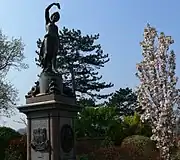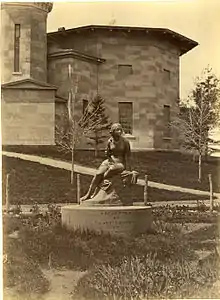| Sabrina Fountain | |
|---|---|
 | |
| Artist | William Burges |
| Year | 1858 |
| Movement | Gothic Revival |
| Condition | unexecuted |
| Location | Victoria and Albert Museum, London |
The Sabrina Fountain was designed by William Burges in 1858. Commemorating the legendary princess Hafren, who was drowned in the River Severn, Burges intended the fountain to stand in the city of Gloucester but it was never executed.
History and description
William Burges designed the fountain in 1858.[1] It was intended to commemorate Hafren (aka Sabrina), a legendary British princess. Geoffrey of Monmouth, in his Historia Regum Britanniae, records that Hafren and her mother were drowned in the River Severn on the orders of her father's first wife, and that the river derives its name from her. The Severn flows through the city of Gloucester and Burges intended that the fountain stand in one of the city's squares. Joseph Mordaunt Crook, the foremost Burges scholar, noted the "quaint grotesquerie" of Burges' designs which illustrate the Sabrina's death and those of her father, Locrinus and her mother Estrildis.[2]
Sabrina is also the subject of John Milton’s play Comus, and Burges’ statue is referenced in Jan Piggot's study, Comus: From text to stage, the fine arts, and book illustration, c.1750-1850.[3]
The fountain was never built. The sketch was used as the frontispiece of the illustrated study of Burges' work, The Architectural Designs of William Burges, authored by his brother-in-law Richard Popplewell Pullan and published after Burges' death.[4] It is now held in the Prints and Drawings Collection at the Victoria and Albert Museum in London.[5]
Other examples
A number of other architects and artists have used Sabrina as a model for fountains, or sculptures. The most directly related is the Crawford Market Fountain in Mumbai, India, designed by William Emerson and decorated by John Lockwood Kipling. Created in 1874, it exhibits remarkable similarities to the Burges fountain, a point noted by Christopher London in his work, Bombay Gothic.[lower-alpha 1][6]
James Milo Griffith created a Sabrina Fountain in 1881. Commemorating Henry Whitmore, Member of Parliament (MP) for Bridgnorth in the mid-19th century, it stands in the grounds of Bridgnorth Castle, Shropshire.[7] A Statue of Sabrina created by the sculptor William Calder Marshall is now owned by Amherst College in the United States, and is the subject of regular student pranks.[8] A modern interpretation, The Apotheosis of Sabrina, of 1980, is by Gerald Laing and stands on Narrow Quay, in Bristol City Centre.[9]
Gallery
 William Emerson's design of 1874 for a fountain in Crawford Market, Mumbai
William Emerson's design of 1874 for a fountain in Crawford Market, Mumbai A current view of the Crawford Market fountain
A current view of the Crawford Market fountain.jpg.webp) Another view of the Crawford Market fountain
Another view of the Crawford Market fountain The Sabrina Fountain at Bridgnorth Castle, Shropshire by James Milo Griffith (1881)
The Sabrina Fountain at Bridgnorth Castle, Shropshire by James Milo Griffith (1881)
 The Apotheosis of Sabrina, Bristol, by Gerald Laing (1980)
The Apotheosis of Sabrina, Bristol, by Gerald Laing (1980)
Footnotes
References
- ↑ Banerjee, Jacqueline. "Unexecuted design for the Sabrina Fountain". Victorian Web. Retrieved 19 October 2023.
- ↑ Crook 1981, p. 68.
- ↑ Piggot, Jan (2014). "Milton's Comus: From text to stage, the fine arts, and book illustration, c.1750-1850". British Art Journal. Retrieved 19 October 2023.
- ↑ Pullan 1887, frontispiece.
- ↑ "Sketch for a fountain for the City of Gloucester". Victoria and Albert Museum. Retrieved 19 October 2023.
- 1 2 London 2002, p. 65.
- ↑ Historic England. "Sabrina Fountain, Bridgnorth (Grade II) (1246858)". National Heritage List for England. Retrieved 19 October 2023.
- ↑ "Sabrina Collection". Amherst College. Retrieved 19 October 2023.
- ↑ "Walking Bristol" (PDF). Bristol City Council. Retrieved 20 October 2023.
Sources
- Crook, J. Mordaunt (1981). William Burges and the High Victorian Dream. London: John Murray. ISBN 978-0-7195-3822-3.
- London, Christopher W. (2002). Bombay Gothic. Mumbai: India Book House. ISBN 978-8-175-08329-5.
- Pullan, Richard Popplewell (1887). The Architectural Designs of William Burges. OCLC 4142972.
